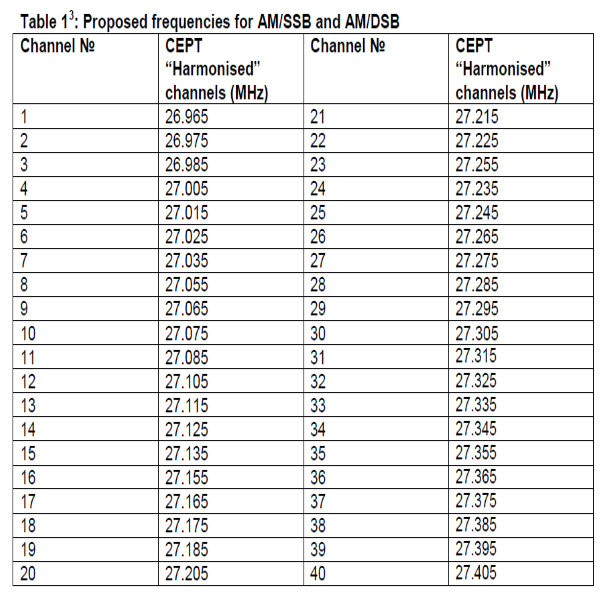UK Citizens’ Band (CB) radio – OFCOM Authorising Amplitude Modulation (AM) and SSB modes of operation from August 2014?
1
Section 1
1 OFCOM Executive Summary
1.1 This Statement sets out Ofcoms decision to proceed with proposals made in our Consultation Citizens Band (CB) radio Authorising Amplitude Modulation (AM) modes of operation (the Consultation’) which was published on 7 October 2013 and closed on 8 November 2013.
1.2 The Consultation proposed to amend current arrangements for Citizens Band (CB) Radio in the UK to allow the use of Amplitude Modulation (AM) Double-sideband (DSB) and Single-sideband (SSB) transmission on CB radio.
1.3 Ofcom specifically proposed to:
Authorise the use of AM emissions on European Conference of Postal and Telecommunications Administrations (CEPT) harmonised channels in line with European Communication Committee (ECC) Decision (11)032; and
Authorise such use on a licence exempt basis (in line with our authorisation approach for other modes of operation for CB).
1.4 These proposals followed on from work carried out in Europe. In June 2011 the ECC, part of CEPT, published a Decision, ECC/DEC/ (11)03 (the Decision) on the harmonised use of frequencies for CB radio equipment. The Decision sought to harmonise the technical standards and usage conditions relating to the use of frequencies for CB radio equipment in CEPT administrations. Our proposals were consistent with the Decision.
1.5 The response to the Consultation was overwhelmingly in favour of our proposals. There were 275 responses to the Consultation, 64 of which were confidential, 210 were non-confidential and 1 was confidential in part. Out of the responses 260 agreed with the authorisation of AM/DSB and AM/SSB use on CB.
1.6 The main concerns expressed by respondents related to the need for effective enforcement, the knowledge and behaviour of CB users and questions surrounding the proposed technical parameters. These issues are explored in more detail in Section 3.
1.7 Given the positive response to the consultation we will proceed to implement the proposals as set out in the Consultation. We will include these changes in the next update of the licence exemption regulations which we expect to come into force by July 2014.
1 http://stakeholders.ofcom.org.uk/binaries/consultations/citizens-band-radio/summary/citizen-band- radio.pdf
2 http://www.erodocdb.dk/Docs/doc98/official/pdf/ECCDEC1103.PDF
Citizens Band (CB) radio Authorising Amplitude Modulation (AM) modes of operation
2
Section 2
2 Introduction and background
Introduction
2.1 On the 7th October 2013 we published a consultation setting out proposals to authorise AM modes of operation on CB radio. In that document we proposed to allow AM/DSB and AM/SSB transmission on CB radio. Currently only frequency and phase modulated emissions are permitted. AM transmission had previously not been permitted in the UK due to concerns over the risk of interference to other radio users.
2.2 The Consultation invited stakeholders to respond to our proposals to authorise AM/DSB and AM/SSB working on CB in accordance with the ECC Decision.
2.3 Over the course of the last few years the European Telecommunication Standards Institute (ETSI) has completed detailed compatibility studies (ETSI TR 102 626) on the impact of AM CB transmission on other domestic and vehicle based spectrum users. The testing did not identify any undue risk of interference and found no outstanding compatibility or sharing issues. ETSI has developed new standards (EN 300-433-1 and 300-433-2) to harmonise the technical parameters applicable to AM on CB and these are reflected in the Decision.
2.4 The Decision looks towards harmonised use across CEPT member countries and provides a set of harmonised technical parameters. ECC decisions are not binding and do not cover the national decisions on authorisation arrangements for individual equipments. However, we believe there are a number of advantages in adopting a harmonised approach to the authorisation of CB.
2.5 The ETSI Report estimated that 95% of equipment sales relate to mobile apparatus and only 5% is fixed. A high percentage of mobile usage is by long distance lorry drivers, many of whom cross international borders throughout Europe. A variety of different national regulations can be very confusing, as the settings on the CB equipment must be checked or changed at each border. Inevitably some equipment will not be changed resulting in illegal use and an increased risk of harmful interference.
Consultation proposals
2.6 We proposed to authorise use of CB in a way that is consistent with the Decision, including permitting AM use of the CEPT frequency bands.
2.7 We proposed that authorisation of AM transmission be achieved through an extension of current licence exemption arrangements for CB.
Frequency Bands
2.8 We proposed to extend the current licensing exemption arrangements to permit AM use in both the single and double sideband mode albeit only in the CEPT harmonised channels identified in Table 1. FM use would of course continue to be authorised on these channels.
2.9 We shall continue to authorise FM only operation on the UK channels. However we have made minor amendments to the Interface Requirement IR 20274 to bring its wording into line with the ECC Decision (11)03.
Transmit power
2.10 In line with the Decision, we proposed to limit the maximum effective radiated power for AM transmission on CB radio to 4 Watts (measured as a root mean square) for DSB modulation and 12 Watts (measured as a peak envelope power) for SSB modulation.
2.11 Compliance with IR2027 is a condition of the exemption regulations. We proposed to revise IR 2027 to reflect the proposed changes. A copy of the draft IR 2027 can be found on our website.5
2.12 Our proposed power limit was specified in terms of a maximum effective radiated power. This means that any gain or loss provided by transmission lines or antenna needs to be taken into account when configuring a station, particularly where a non-integral antenna is used. We leave it to individual users to decide how to configure
3 The frequencies indicated in this table are the centre frequencies of each channel number. The maximum operating frequency band shall be from 26.960 MHz to 27.410 MHz for the CEPT
4 http://stakeholders.ofcom.org.uk/binaries/spectrum/spectrum-policy-area/spectrum-management/research-guidelines-tech-info/interface-requirements/uk2027.pdf
5 http://stakeholders.ofcom.org.uk/spectrum/technical/interface-requirements/draft_ir/

